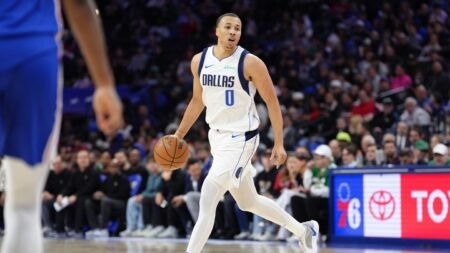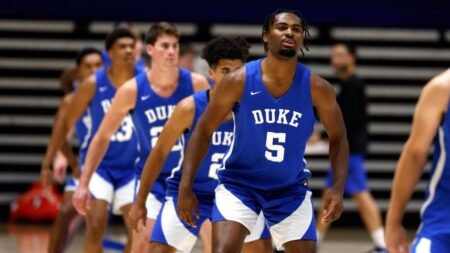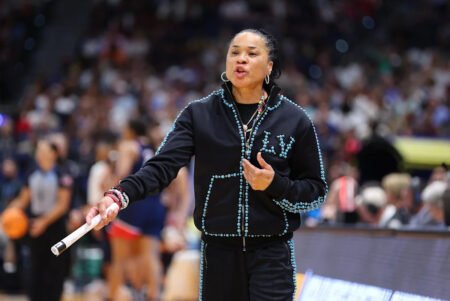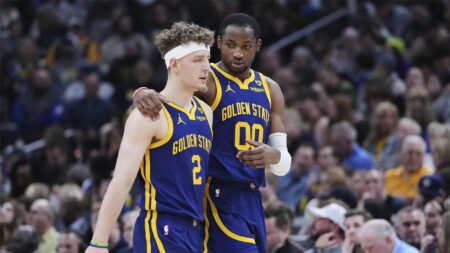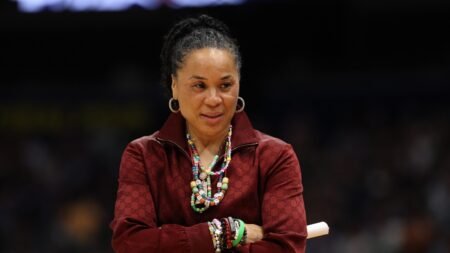Whether it’s a blowout victory for Duke in front of a rowdy Cameron Indoor Stadium or a big loss for a low-major team playing in one of the sport’s remote outposts, they will be there. In an era of mass transferring and unprecedented roster turnover that can leave fans bewildered as to who even plays for their favorite team, mascots never enter the portal.
While the person inside the suit may change, the costumed manifestation of school pride is always there patrolling the baseline, interacting with fans and channeling the unique school pride that makes college sports so authentic. Mascots aren’t just furry photo-ops. They are iconic symbols, and they are an institution in college basketball.
While they all serve essentially the same purpose, none are exactly the same or even based in obvious logic. Paydirt Pete at UTEP wears jeans and wields a pickaxe, which makes sense consider UTEP is the Miners. But then there’s the Stanford tree, who represents a school nicknamed the Cardinal.
What makes a good college basketball mascot is up for debate. For some, it may be the costume. For others, it may be the rituals or the connection to school history. But as with anything in sports, the best mascots is a topic that’s up for debate.
For this week’s Dribble Handoff, our writers are picking college basketball’s best mascots.
Any list of college basketball’s best mascots has to start on Hawk Hill — where “The Hawk Will Never Die” is the official motto attached to The Hawk, Saint Joseph’s big-eyed bird that famously never stops flapping its wings from tip-off through the final buzzer.
Overtime games can be especially challenging.
I’ve sat courtside at Hagan Arena and seen it with my eyes — and I can’t be the only human who has watched The Hawk up close and then, just randomly, decided to give flapping a shot. Flap. Flap. Flap. There I was, right in the middle of the game, flapping my stupid arms, at which point I realized pretty quickly that two basketball-halves of non-stop flapping is no joke. Only a truly fit person could pull it off. I quit after a few minutes because my arms were tired. Typing is much easier. — Gary Parrish
Cosmo the Cougar (BYU)
We’re talking mascots and not monikers, right? Because those are two different things. “Cougars” is not one of the best monikers in college sports, but BYU’s Cougar mascot is the best of the bunch. I don’t even think it’s arguable. His name is Cosmo and he’s a better athlete than probably 90% of the population in men’s college hoops.
Oh, don’t believe me?
Check out this sizzle real. The pushups with the folding tables. Seriously: WHAT???
The person inside the costume deserves at least $1 million in NIL. I’m not kidding: This is the best mascot not just in college sports, but in the entire country. From jumping out of planes to trampolining from the 3-point line to flinging himself through fire, Cosmo is unbeatable. My colleagues here have some great nominations, but they all fall well short of the crazy Coug. College sports’ charm includes the characters and caricatures that are mascots, but come on: BYU’s big cat beats ’em all with ease. Here, watch some more outrageousness. Then consider he’ll be doing new stunts as soon as this weekend and for the upcoming football and basketball seasons. — Matt Norlander
Call me a homer all you want — I deserve it in this case! — but Pistol Pete is a mascot that for me as a born-and-raised Oklahoman is synonymous with college sports. The Oklahoma State mascot originated from an actual person, Frank B. Eaton, who, well, I’ll let OSU take away the backstory.
The character of OSU’s mascot, Pistol Pete, originated from an actual person named Frank B. Eaton. Eaton’s life began in 1860 in Hartford, Connecticut. Eaton and his family moved to Kansas shortly after the Civil War.
Eaton’s life would take a dramatic turn at the age of eight when he witnessed the murder of his father by six vigilantes. From that moment on, Eaton was determined to even the score. He practiced his marksmanship until the age of 15, when he set out to search for his father’s killers. It took Eaton more than five years to track down and kill the men who had taken his father away, forever changing the course of his life.
The title of “cowboy” came naturally to Eaton as indicated in the roles in which he served throughout his life. Frank B. Eaton was given the nickname of “Pistol Pete” after beating out many cavalry competitors in a marksmanship contest at Ft. Gibson. He served as a U.S. Deputy Marshall under “hanging judge” Isaac Parker. Later in his life Eaton owned a blacksmith shop which served the surrounding communities.
On gamedays at Oklahoma State, Pete’s blasting gun sets off an “OHHHHHHHH-SSSSSSSSSSSS-UUUUUUUUUU! COWBOYS!” chant to rally Cowboys fans. And his blank stare hidden behind his gruff five o’clock shadow is a perfect combo of majesticness and mysteriousness. He’s equal parts scary and motivational — exactly what every team should want from their respective mascot. — Kyle Boone
The Demon Deacon at Wake Forest is one the few college mascots who inspires genuine fear. He doesn’t wield an axe or a gun and he has no claws and no fangs. But the absence of teeth are part of what makes him so scary. The old man just stares blankly into your soul, making you ponder nervously, “what exactly is a demon deacon?”
According to legend, the nickname stems from a moniker given to Wake Forest’s football team by a writer after the school’s “devilish” win over Duke in the 1920s. For a school with Baptist roots, “deacon” is an homage to a church leader. But a demonic version of a deacon is an oxymoronic and frightening figure straight from a horror movie. The discomforting appearance of the Wake Forest mascot perfectly embodies that dichotomy. — David Cobb
The Blue Devil (Duke)
I went with the mascot that not only looks intimidating and would possibly win in a fight against other mascots in college basketball, but is part of one of college basketball’s biggest brands. The Blue Devil is depicted as a humanoid character with a blue and white cape. The mascot also usually wears white tape on their forehead with different messaging — depending on the game — written on it.
The Blue Devil has been Duke’s mascot for more than 100 years. The name originates from French soldiers during World War I, known as les Diables Bleus, who wore blue uniforms, berets and flowing capes. There is your history lesson for the day. Did I mention that the mascot is cool to look at? — Cameron Salerno
Read the full article here







